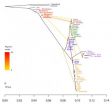(Press-News.org) The discovery of insulin nearly a century ago changed diabetes from a death sentence to a chronic disease.
Today a team that includes researchers from Case Western Reserve University School of Medicine announced a discovery that could lead to dramatic improvements in the lives of people managing diabetes.
After decades of speculation about exactly how insulin interacts with cells, the international group of scientists finally found a definitive answer: in an article published today in the journal Nature, the group describes how insulin binds to the cell to allow the cell to transform sugar into energy—and also how the insulin itself changes shape as a result of this connection.
"These findings carry profound implications for diabetes patients," said Case Western Reserve biochemistry professor and department chair Michael A. Weiss, MD, PhD, MBA, one of the leaders of the team. "This new information increases exponentially the chances that we can develop better treatments—in particular, oral medications instead of syringes, pens or pumps."
Weiss, also the Cowan-Blum Professor of Cancer Research at the School of Medicine, is renowned worldwide for his work on insulin. In 1991 he used nuclear magnetic resonance techniques to describe the structure of insulin; more recently he has developed a preliminary version of the hormone that does not need to be refrigerated, a critical breakthrough for those with diabetes in the developing world.
The results published today, however, represent among the most promising for Weiss and an entire generation of scientists devoted to enhancing care for those suffering from diabetes. They have sought to solve mystery of how the hormone bound to cells since 1969, when the late Dorothy Hodgkin and colleagues at the University of Oxford, first described insulin's structure.
"There's been a logjam in our understanding since then," Weiss said. "We hope that we've broken the logjam."
The magnitude of the challenge is, in part, evidenced by the diversity of the team required to overcome it. Weiss partnered with Associate Professor Mike Lawrence, of the Walter and Eliza Hall Institute of Medical Research in Melbourne, Australia, to lead the project. They, in turn, engaged scientists from the University of Chicago, the University of York in the United Kingdom, and the Institute of Organic Chemistry and Biochemistry in Prague in the Czech Republic.
The scientists recognized that cells absorb sugar from food as energy for the body, yet glucose can't penetrate a cell's membrane without help from insulin, a hormone secreted from endocrine cells in the pancreas. To absorb the sugar, most cells have insulin "receptors" that bind the hormone as it flows through the bloodstream.
The researchers tested structural models using molecular-genetic methods to insert probes that, in turn, are activated by ultra-violet light into the receptor. The procedure creates highly detailed, three-dimensional images—which provided critical answers for Weiss, Lawrence and their colleagues.
"Both insulin and its receptor undergo rearrangement as they interact," Lawrence said. "A piece of insulin folds out and key pieces within the receptor move to engage the insulin hormone. You might call it a 'molecular handshake.'"
Understanding the bonding mechanics offers possible advances in how diabetes is treated, now usually with daily, multiple insulin injections. The discovery, Weiss said, suggests that targeting small molecules "to the signaling clefts" of the receptor may allow for alternatives to injections, as well as fewer doses per day.
Diabetes patients develop high blood sugar from inadequate insulin production, imperfect cellular to insulin, or both. The disease can cause wide-ranging complications, from heart disease, stroke and high blood pressure to blindness and kidney problems.
Diabetes affects nearly 26 million—or more than 8 percent—of the U.S. population and rising, according to the Centers for Disease Control.
###
The research team also included:
from Case Western Reserve, Jonathan Whittaker, PhD, associate professor of biochemistry, and research assistant Linda Whittaker;
from the Walter and Eliza Hall Institute of Medical Research, professor Colin Ward and Dr. John Menting;
from the University of York, the late Guy G. Dodson, Professor and Head, Crystallography; and
from the University of Chicago, Donald G. Steiner, N. Pritzker Distinguished Service Professor Emeritus in the Departments of Medicine and Biochemistry and Molecular Biology.
About Case Western Reserve University School of Medicine
Founded in 1843, Case Western Reserve University School of Medicine is the largest medical research institution in Ohio and is among the nation's top medical schools for research funding from the National Institutes of Health. The School of Medicine is recognized throughout the international medical community for outstanding achievements in teaching. The School's innovative and pioneering Western Reserve2 curriculum interweaves four themes--research and scholarship, clinical mastery, leadership, and civic professionalism--to prepare students for the practice of evidence-based medicine in the rapidly changing health care environment of the 21st century. Nine Nobel Laureates have been affiliated with the School of Medicine.
Annually, the School of Medicine trains more than 800 MD and MD/PhD students and ranks in the top 25 among U.S. research-oriented medical schools as designated by U.S. News & World Report's "Guide to Graduate Education."
The School of Medicine's primary affiliate is University Hospitals Case Medical Center and is additionally affiliated with MetroHealth Medical Center, the Louis Stokes Cleveland Department of Veterans Affairs Medical Center, and the Cleveland Clinic, with which it established the Cleveland Clinic Lerner College of Medicine of Case Western Reserve University in 2002. http://casemed.case.edu
After decades of research, scientists unlock how insulin interacts with cells
Discovery could lead to dramatic improvements for people managing diabetes
2013-01-10
ELSE PRESS RELEASES FROM THIS DATE:
GW researchers find variation in foot strike patterns in predominantly barefoot runners
2013-01-10
WASHINGTON –A recently published paper by two George Washington University researchers shows that the running foot strike patterns vary among habitually barefoot people in Kenya due to speed and other factors such as running habits and the hardness of the ground. These results are counter to the belief that barefoot people prefer one specific style of running.
Kevin Hatala, a Ph.D. student in the Hominid Paleobiology doctoral program at George Washington, is the lead author of the paper that appears in the recent edition of the journal Public Library of Science, or PLOS ...
A history lesson from genes
2013-01-10
When Charles Darwin first sketched how species evolved by natural selection, he drew what looked like a tree. The diagram started at a central point with a common ancestor, then the lines spread apart as organisms evolved and separated into distinct species.
In the 175 years since, scientists have come to agree that Darwin's original drawing is a bit simplistic, given that multiple species mix and interbreed in ways he didn't consider possible (though you can't fault the guy for not getting the most important scientific theory of all time exactly right the first time). ...
Study examines how news spreads on Twitter
2013-01-10
Nearly every major news organization has a Twitter account these days, but just how effective is the microblogging website at spreading news? That's the question University of Arizona professor Sudha Ram set out to answer in a recent study of a dozen major news organizations that use the social media website as one tool for sharing their content.
The answer, according to Ram's research, varies widely by news agency, and there may not be one universally applicable strategy for maximizing Twitter effectiveness. However, news agencies can learn a lot by looking at how their ...
Unnecessary antimicrobial use increases risk of recurrent infectious diarrhea
2013-01-10
The impact of antibiotic misuse has far-reaching consequences in healthcare, including reduced efficacy of the drugs, increased prevalence of drug-resistant organisms, and increased risk of deadly infections. A new study featured in the February issue of Infection Control and Hospital Epidemiology, the journal of the Society for Healthcare Epidemiology of America, found that many patients with Clostridium difficile infection (C. difficile) are prescribed unnecessary antibiotics, increasing their risk of recurrence of the deadly infection. The retrospective report shows ...
Flooding preparedness needs to include infection prevention and control strategies
2013-01-10
Flooding can cause clinical and economic damage to a healthcare facility, but reopening a facility after extensive flooding requires infection prevention and control preparedness plans to ensure a safe environment for patients and healthcare workers. In a study published in the February issue of Infection Control and Hospital Epidemiology, the journal of the Society for Healthcare Epidemiology of America, clinical investigators report key findings and recommendations related to the closure and re-opening of hospitals impacted by black-water floods. The guidance builds on ...
Faulty behavior
2013-01-10
PASADENA, Calif.—In an earthquake, ground motion is the result of waves emitted when the two sides of a fault move—or slip—rapidly past each other, with an average relative speed of about three feet per second. Not all fault segments move so quickly, however—some slip slowly, through a process called creep, and are considered to be "stable," or not capable of hosting rapid earthquake-producing slip. One common hypothesis suggests that such creeping fault behavior is persistent over time, with currently stable segments acting as barriers to fast-slipping, shake-producing ...
Next-generation adaptive optics brings remarkable details to light in stellar nursery
2013-01-10
A new image released today reveals how Gemini Observatory's most advanced adaptive optics (AO) system will help astronomers study the universe with an unprecedented level of clarity and detail by removing distortions due to the Earth's atmosphere. The photo, featuring an area on the outskirts of the famous Orion Nebula, illustrates the instrument's significant advancements over previous-generation AO systems.
"The combination of a constellation of five laser guide stars with multiple deformable mirrors allows us to expand significantly on what has previously been possible ...
Microscopic blood in urine unreliable indicator of urinary tract cancer
2013-01-10
Rochester, MN, January 9, 2013 – Microscopic amounts of blood in urine have been considered a risk factor for urinary tract malignant tumors. However, only a small proportion of patients referred for investigation are subsequently found to have cancer. A new Kaiser Permanente Southern California study published in the February Mayo Clinic Proceedings reports on the development and testing of a Hematuria Risk Index to predict cancer risk. This could potentially lead to significant reductions in the number of unnecessary evaluations.
Individuals with microscopic hematuria ...
Small price differences can make options seem more similar, easing our buying decisions
2013-01-10
Some retailers, such as Apple's iTunes, are known for using uniform pricing in an effort to simplify consumers' choices and perhaps increase their tendency to make impulse purchases. But other stores, like supermarkets, often have small price differences across product flavors and brands.
As counterintuitive as it might seem, these small price differences may actually make the options seem more similar, according to new research published in Psychological Science, a journal of the Association for Psychological Science. The research shows that adding small differences ...
Online message boards provide outlets for mothers' concerns, MU researcher says
2013-01-10
COLUMBIA, Mo. –Parenting infants and toddlers can be challenging, and for generations, mothers have turned to other moms for advice. Now, with the availability of the Internet, mothers are consulting each other using modern venues: online message boards. Research from the University of Missouri indicates online discussion boards provide safe environments for mothers to anonymously express child-rearing concerns and receive support from other moms.
"Mothers have feelings that they might be embarrassed to talk about face-to-face with someone," said Jean Ispa, professor ...
LAST 30 PRESS RELEASES:
Scalable and healable gradient textiles for multi‑scenario radiative cooling via bicomponent blow spinning
Research shows informed traders never let a good climate crisis go to waste
Intelligent XGBoost framework enhances asphalt pavement skid resistance assessment
Dual-function biomaterials for postoperative osteosarcoma: Tumor suppression and bone regeneration
New framework reveals where transport emissions concentrate in Singapore
NTP-enhanced lattice oxygen activation in Ce-Co catalysts for low-temperature soot combustion
Synergistic interface engineering in Cu-Zn-Ce catalysts for efficient CO2 hydrogenation to methanol
COVID-19 leaves a lasting mark on the human brain
Scientists use ultrasound to soften and treat cancer tumors without damaging healthy tissue
Community swimming program for Black youth boosts skills, sense of belonging, study finds
Specific depressive symptoms in midlife linked to increased dementia risk
An ‘illuminating’ design sheds light on cholesterol
Who is more likely to get long COVID?
Study showcases resilience and rapid growth of “living rocks”
Naval Research Lab diver earns Office of Naval Research 2025 Sailor of the Year
New Mayo-led study establishes practical definition for rapidly progressive dementia
Fossil fuel industry’s “climate false solutions” reinforce its power and aggravate environmental injustice
Researchers reveal bias in a widely used measure of algorithm performance
Alcohol causes cancer. A study from IOCB Prague confirms damage to DNA and shows how cells defend against it
Hidden viruses in wastewater treatment may shape public health risks, study finds
Unlock the power of nature: how biomass can transform climate mitigation
Biochar reshapes hidden soil microbes that capture carbon dioxide in farmland
Reducing saturated fat intake shows mortality benefit, but only in high-risk individuals
Manta rays create mobile ecosystems, study finds
Study: Mixed results in using lipoic acid to treat progressive multiple sclerosis
Norbert Holtkamp appointed director of Fermi National Accelerator Laboratory
New agentic AI platform accelerates advanced optics design
Biologists discover neurons use physical signals — not electricity — to stabilize communication
Researchers discover that a hormone can access the brain by hitchhiking
University of Oklahoma researcher awarded funding to pursue AI-powered material design
[Press-News.org] After decades of research, scientists unlock how insulin interacts with cellsDiscovery could lead to dramatic improvements for people managing diabetes



